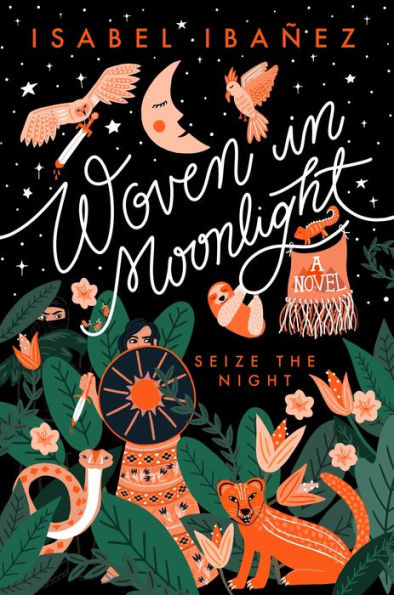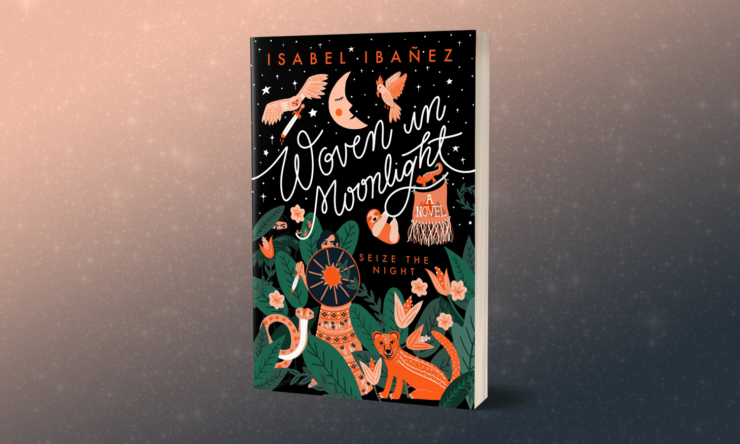Isabel Ibañez kicks off the year as one of the first authors to debut in the New Roaring Twenties. If the rest of the debuts are this promising, then we’re going to have a very good year. Woven in Moonlight draws inspiration from Bolivian politics and history to create a fantastical world. In fact, YA fantasy hasn’t seen a world like the Kingdom of Inkasisa. Full disclosure: As someone born and partially raised in Ecuador, I’ve been waiting my whole life to read a book that takes the Andean history of the Spanish and Inca, and transforms it in a fantastical setting.
Woven in Moonlight follows Ximena Rojas, the decoy Condesa of the secondary world of Inkasisa that has been upturned by revolution. Ximena is an Illustrian, the former ruling class, who are now relegated to living in a fortified keep. Ximena has had to pretend to be someone else for a decade. Ten years of being Condesa Catalina, the last living royal. Ximena’s longing for her own identity is clear, as is her fierce loyalty to the real Condesa and her Illustrian people. She fumbles as a decoy ruler quite a bit, usually by being unable to say the things people want to hear. It’s refreshing to see her faults and the promise of her strength as a character. Her only solace is her brand of magic. All people of Inkasisa possess traces of magic—reading the stars, tremors, healing, etc. Some, like Ximena can pull moonlight and weave it like wool to create tapestries.
When a group of Illustrian spies are captured by the enemy, and the false king Atoc demands the Condesa’s hand in marriage as an exchange for their lives, it is Ximena who is sent across the magical bridge and into the castle. King Atoc is a tyrannical ruler who shows no mercy. He lead the Llacsan revolt against the Illustrian aristocracy after four hundred years of oppression by using his power of earthquakes as well as a weapon called La Estrella—a gem that summons a ghost army to fight. Meanwhile, a vigilante only known as El Lobo, is stirring up trouble for the leaders on both sides. Ximena has eight weeks to find La Estrella (which king Atoc has hidden) or kill the king. But life in the castle isn’t what she’d expected, and so begins Ximena’s journey as a spy and a girl who might just heal a kingdom with centuries of bloodshed as its foundation.
There are some things that Ibañez handles with great care. The binary of good and evil is thwarted and at often times left unresolved. The reader is never spoon-fed the answers on who to root for because that isn’t Ximena’s path. She is faced, for the first time in her life, with having to live with the Llacsan as a fiancé-prisoner (awkward). The differences are superficial, which seems intentional. They let chickens and animals roam free in the castle. Their clothes are extremely bright and celebratory. Llacsans are the indigenous people of Inkasisa, and are coded by their deep bronze skin. The Illustrians are differentiated with neutral clothes, and light to olive tone skin. After four hundred years, they share language and food, the importance of education and family. Ximena starts off the novel unable to understand why the Llacsan can’t simply go back to the way things were, and it isn’t until she’s forced to relive the past, that she realizes the Illustrian version of the past is rife with ignorance and injustice. Everyone from her handmaiden, to her personal guards, to the castle healer she loves to clash with, is a cold awakening to the wrongs of her own people. Reconciling that doesn’t come easily, but Ibañez doesn’t shy away from it.
Buy the Book


Woven in Moonlight
Some of the best moments are when Ibañez lingers in Ximena’s exploration of the castle and the people she gets close to. In particular, the moments when she and the healer, Rumi is there to challenge every truth she’s held dear. For the romance lovers, there is a delightfully satisfying arc that comes with all the push and pull of forbidden love. They challenge each other at every turn, even when sharing a meal. Warning: do not come into this book hungry. The food descriptions of Bolivian staples like salteñas will have you Google-mapping the nearest Bolivian restaurant nearby.
The search for La Estrella becomes all the more complicated when Ximena is forced to team up with El Lobo, the vigilante that’s made her life complicated as decoy Condesa. As Ximena begins to question her loyalty to her crown, she finds that being in the castle has awakened a new ability. Her weaving transforms and comes alive in a way that it never has before and creates anticipation for the next time Ximena sits at a loom. What you’ll find here is a character who doesn’t eschew her femininity in favor for the masculine. Ximena is many things: Naive, clever, fierce, hopeful, compassionate, brave, soft, and open. She’s not a single thing, which makes her a stand-out heroine. Don’t get me wrong. Ximena knows how to wield a sword, too. She was trained to protect her Condesa, after all. But she also creates living art with her magic.
Stylistically, the Llacsan names are in Quechua, and their language is referred to as “the old language.” Ibañez uses Spanish as the fantasy magical language, and even if readers don’t come with a rudimentary understanding of the words, the context clues should suffice. You will find that in some instances, Ximena recaps the long history of Inkasisa in chunks, but it’s an effective use of telling and keeps the tight prose and expertly paced events moving quickly.
King Atoc at times felt like two-dimensional tyrant, but I might argue that fantasy is idealistic in nature, creating a binary to root for in the first place. However, there is no shortage of female characters for Ximena to interact with and help her change the way that she views the world for the better. This is a protagonist you want to champion.
With gorgeous magic, a strong narrative voice, and a satisfying finale, Woven in Moonlight by Isabel Ibañez opens up a whole new world for readers and is a debut author whose career you want to watch.
Woven in Moonlight is available from Page Street Publishing.
Zoraida Córdova is the award-winning author of the Brooklyn Brujas series, The Vicious Deep trilogy, and Star Wars: A Crash of Fate. Her short fiction has appeared in the New York Times bestselling anthology Star Wars: From a Certain Point of View, and Toil & Trouble: 15 Tales of Women and Witchcraft. Zoraida was born in Ecuador and raised in Queens, New York. When she isn’t working on her next novel, she’s planning her next adventure.










